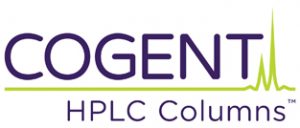It may be worth looking into allowed changes and consider using new technology columns such as the Cogent TYPE-C™, without having to revalidate the method. The benefits of switching include saving solvents, time, longer column life and repeatability of the results.
USP (United States Pharmacopoeia) existing methods for analysis of drugs or active compounds are very frequently used in the pharmaceutical industry because they do not need to be validated if they can be set up and demonstrated that they pass system suitability requirements, which include:
- A minimum resolution between the active ingredient and a related compound or impurity
- A relative standard deviation (RSD) of <2% for the peak area of replicate injections of the active drug (compound)
- A USP tailing factor (TF) of <2
Most scientists are reluctant to make any changes in the USP methods because they may have to re-validate the method (costly and time consuming procedure). However in Chapter 621 of the USP [1] there is a list of adjustments than can be made to existing methods without re-validation, of course that system suitability still has to pass. For example USP allows a change in column length of + 70%.
[1]. United States Pharmacopeia 34-National Formulary 29 (United States Pharmacopeial Convention, Rockville, MD, 2011).


